Flower beds are living works of art formed by layering plants of different shapes, sizes, and colors together to create a cohesive garden design. Often, garden beds include large foundation plants as well as an assortment of smaller perennials and annuals. Gardens can also make use of border plants to delineate spaces, soften the lines around garden edges and walkways and add extra color too.

The right border plants can elevate the appearance of your garden and help your landscape design look more finished and tidy. But if you haven’t worked with border plants before, you may not know what plants will grow best in your garden. To help you out, we’ve compiled this list of the best edging plants to improve the look of lawn and garden borders.
Jump to:
- 20 best plants for attractive lawn and garden borders
- 1. Lavender (Lavandula spp.)
- 2. Coral bells (Heuchera spp.)
- 3. Roman chamomile (Chamaemelum nobile)
- 4. Monkey grass (Liriope muscari)
- 5. Daylily (Hemerocallis spp.)
- 6. Hostas (Hosta spp.)
- 7. Tricolor sage (Salvia officinalis)
- 8. Cinquefoil (Potentilla spp.)
- 9. Sedum (Sedum spp.)
- 10. Creeping thyme (Thymus serpyllum)
- 11. Boxwood (Buxus sempervirens)
- 12. Dwarf fountain grass (Pennisetum alopecuroides)
- 13. Sweet alyssum (Lobularia maritima)
- 14. Lady’s mantle (Alchemilla mollis)
- 15. Irish moss (Sagina subulata)
- 16. Astilbe (Astilbe spp.)
- 17. Catmint (Nepeta racemosa)
- 18. Mophead hydrangea (Hydrangea macrophylla)
- 19. Moss phlox (Phlox subulata)
- 20. Azaleas (Rhododendron spp.)
- Summary
20 best plants for attractive lawn and garden borders
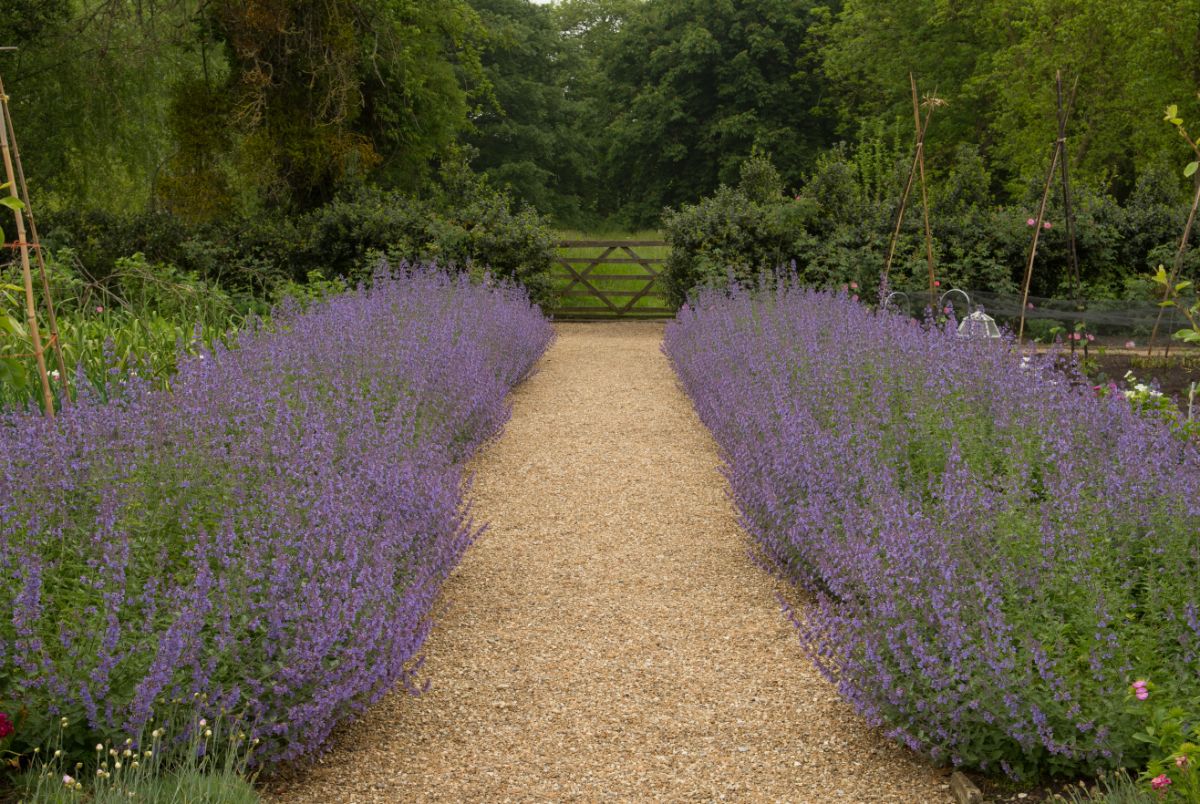
Many border plants are grown for their unique foliage, but some plants boast colorful flowers or other special features. In the list below, we’ve added an assortment of edging plants to give you lots of options to choose from.
Some border plants will thrive in sun or shade, while others can tolerate foot traffic or drought. No matter your garden size or growing conditions, you’ll find the right border plants for you right here!
1. Lavender (Lavandula spp.)
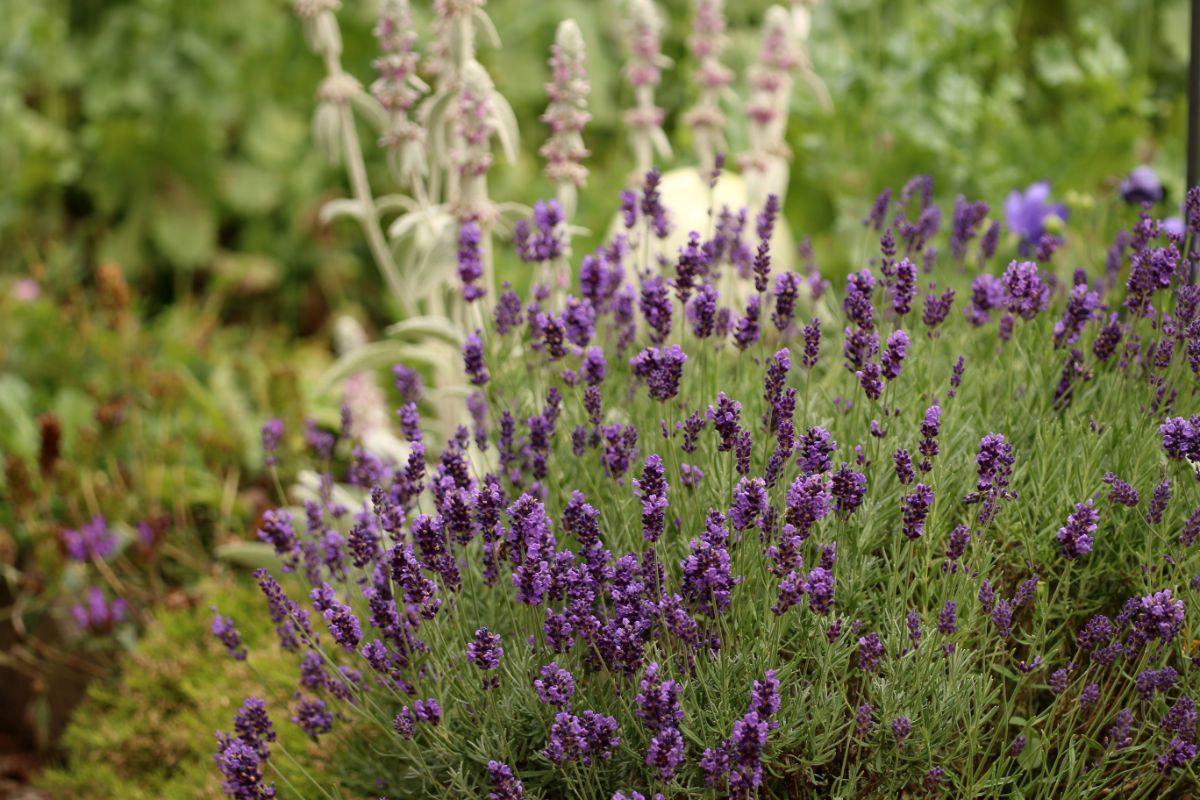
| Plant name: | Lavender |
| Light requirements: | Full sun |
| Water requirements: | Low |
| Growing zone: | Zones 5 to 9, depending on variety |
| Special features: | Fragrant; Edible; Attracts pollinators; Ideal for dried flowers and other crafts |
Most border plants are grown for their colorful leaves and showy flowers; however, lavender is a treat for all of the senses! Lavender is an appealing plant with darling purple flowers and silvery-green leaves, but it’s also one of the most fragrant plants you can keep. When planted as a border plant, you’ll be able to enjoy the rich scent of lavender every time you take a stroll in your garden.
There are 47 different species of lavender, including some varieties that are more tolerant of humidity than others. Most lavender needs minimal water, and it thrives in well-draining, sandy soil and full sun.
2. Coral bells (Heuchera spp.)
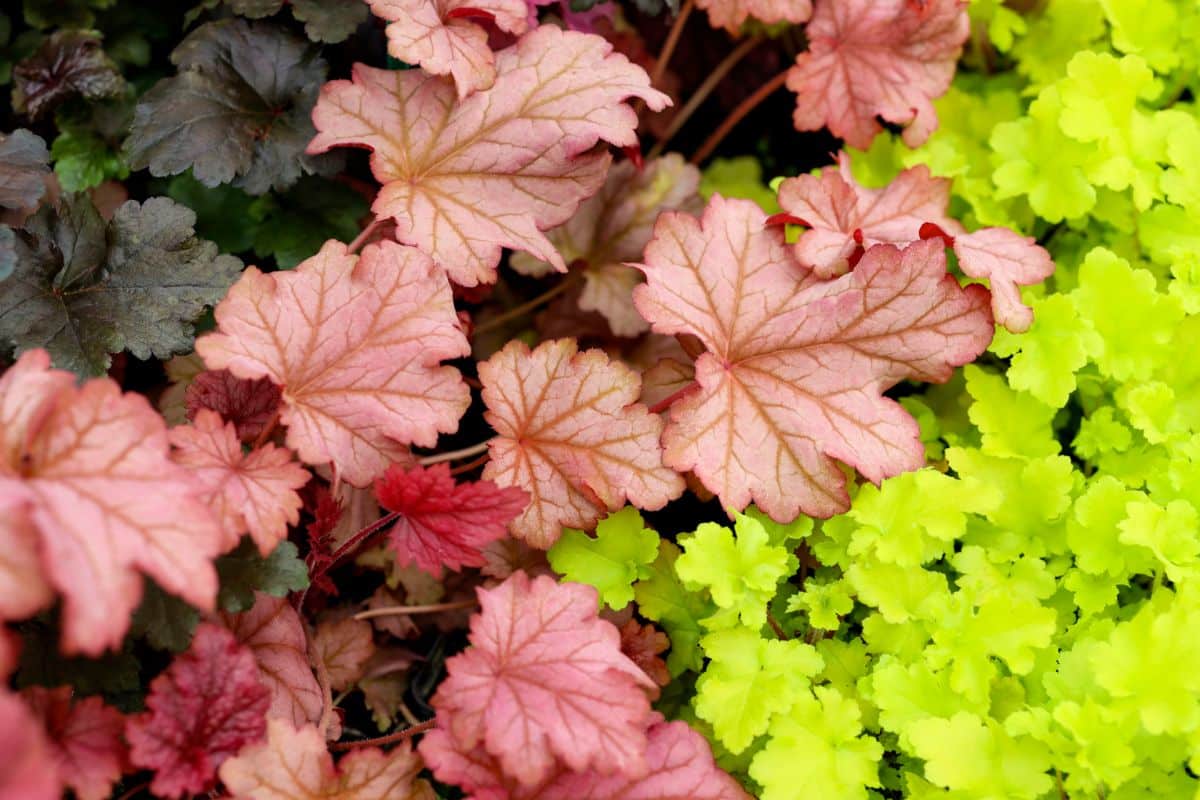
| Plant name: | Coral bells |
| Light requirements: | Part shade |
| Water requirements: | Moderate |
| Growing zone: | Zones 4 to 9 |
| Special features: | Colorful foliage; Attracts pollinators |
Also known as alumroot, coral bells are an ideal border plant to grow if you want to add more color to your garden beds. Coral bells are flowering plants, but they are mostly kept for their vividly colored leaves, which come in various shades of purple, chartreuse, copper, orange, and other saturated hues.
Native to North America, coral bells are quite hardy, and they grow as perennials in zones 4 to 9. These plants are also attractive to pollinators, and they are well-suited to shady garden beds.
3. Roman chamomile (Chamaemelum nobile)
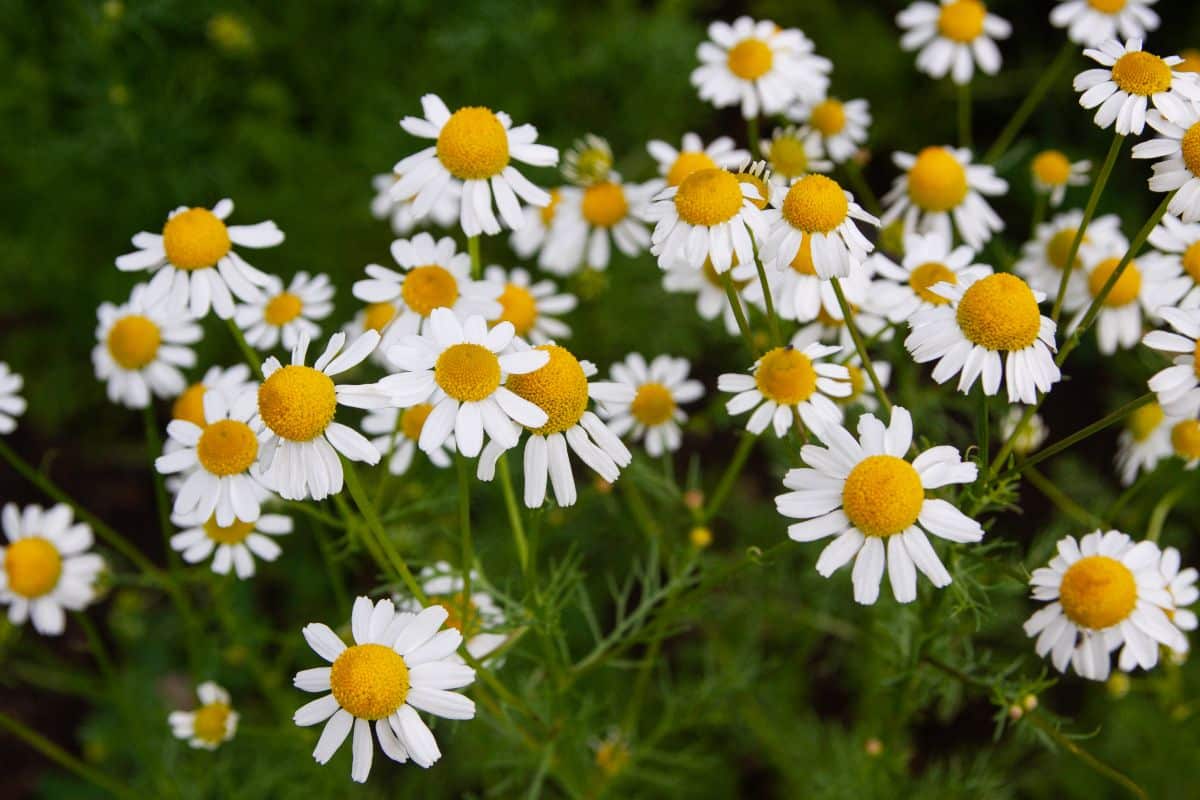
| Plant name: | Roman chamomile |
| Light requirements: | Full sun to part shade |
| Water requirements: | Moderate |
| Growing zone: | Zones 4 to 9 |
| Special features: | Fragrant; Edible; Attracts pollinators; Ideal for dried flowers and other crafts |
If you like the idea of keeping lavender as a border plant, you may also want to grow Roman chamomile. Roman chamomile is another fragrant herb that is often used for tea making, but it is a hardy, no-fuss ornamental as well. As it grows, Roman chamomile forms a thick, spreading mat of leaves and flowers, but it rarely reaches over 6” tall, making it a great choice for the front of flower beds.
When growing chamomile, make sure you know which variety you have. While Roman chamomile grows as a perennial, German chamomile is an annual plant, and it grows up to 3’ tall.
4. Monkey grass (Liriope muscari)
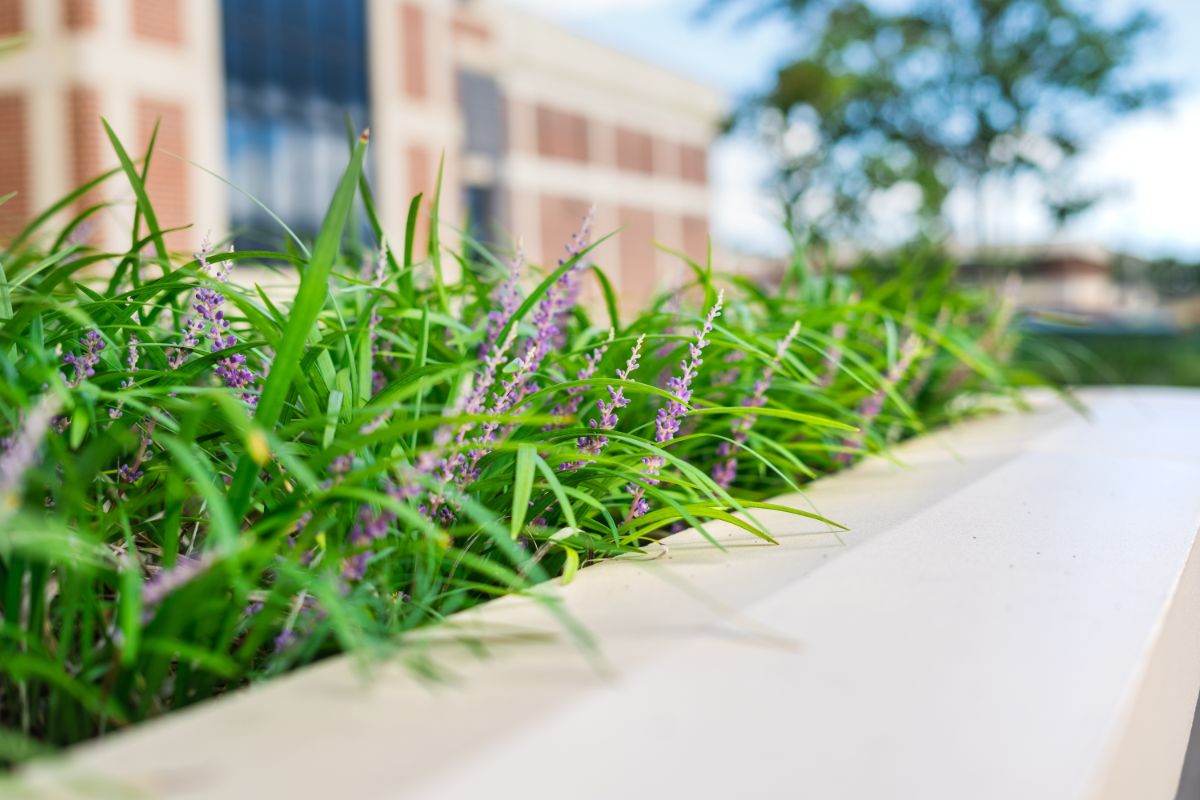
| Plant name: | Monkey grass |
| Light requirements: | Full sun to part shade |
| Water requirements: | Moderate to low |
| Growing zone: | Zones 5 to 10 |
| Special features: | Drought tolerant; Flowers in summer |
Monkey grass is known for its rich green, grass-like leaves that add lots of texture and color to garden beds. But this plant also produces tall, purple flower spikes in summer, which look a lot like the blooms of grape hyacinths.
Growing as a perennial in zones 5 to 10, monkey grass only reaches about 12” tall, and it forms neat little clusters of grass as it spreads, adding a classic touch to garden beds and walkways. What’s more, monkey grass is super low maintenance, and it’s adaptable enough to grow in part shade or full sun!
5. Daylily (Hemerocallis spp.)

| Plant name: | Daylily |
| Light requirements: | Full sun to part shade |
| Water requirements: | Moderate |
| Growing zone: | Zones 2 to 11, depending on variety |
| Special features: | Colorful flowers; Divides easily |
Daylilies are easy-going plants that will reward you with colorful flowers in various shades of orange, yellow, and red. Their grass-like leaves also add texture and movement when grown along garden walkways and at the border of ornamental beds. You can find daylilies in various sizes too, so if you’re worried about them overshadowing smaller plants, look for dwarf daylily cultivars that stay under 2’ tall.
Daylilies are generally grown from bulbs, which can be planted in either spring or fall. Over time, these plants also spread vigorously, providing you with lots more daylily plants for your garden. Plan on dividing daylilies about once every 3 to 5 years and then sow the new plant starts throughout your garden.
6. Hostas (Hosta spp.)
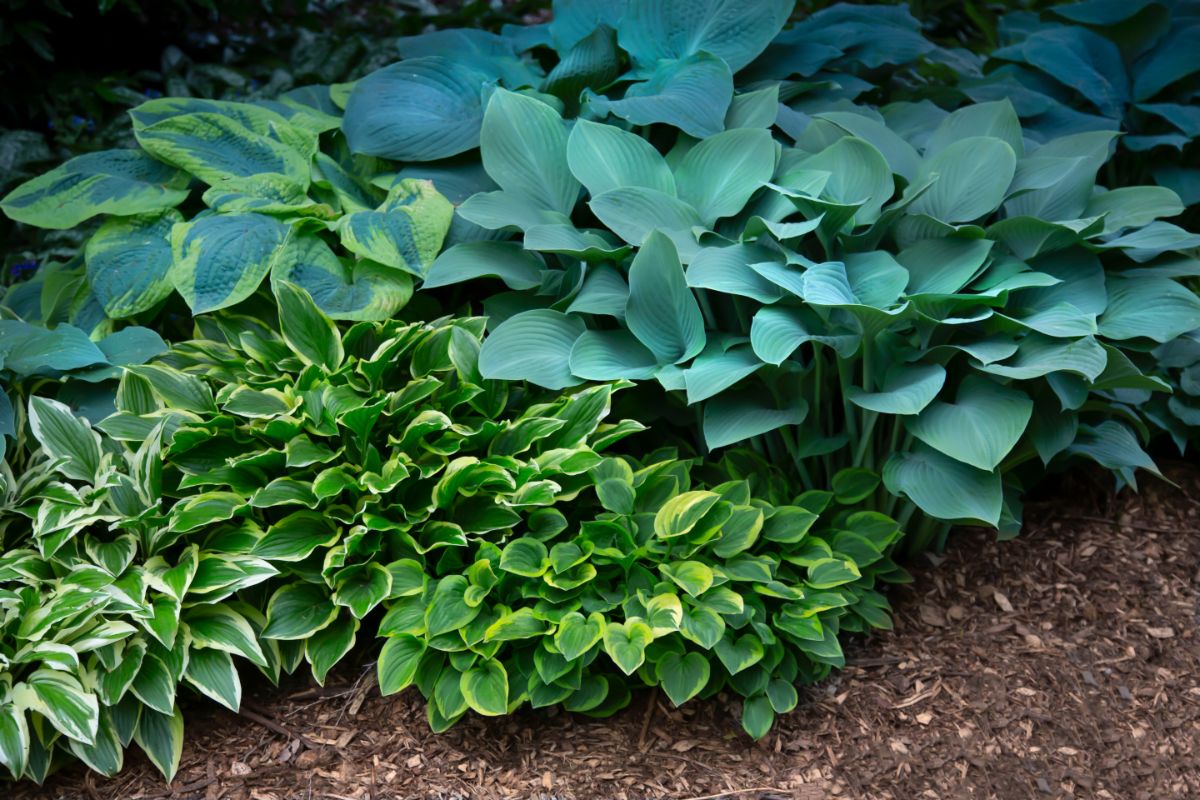
| Plant name: | Hostas |
| Light requirements: | Part sun to shade |
| Water requirements: | Moderate |
| Growing zone: | Zones 3 to 9 |
| Special features: | Shade tolerant; Attracts pollinators; Edible |
Hostas are one of the most popular border plants for a good reason. Hostas are incredibly low-maintenance plants that need very little care once they’re established in gardens. Plus, these plants can thrive in shady spots where other plants won’t take root!
Hostas come in an incredible range of sizes and colors – from dwarf hostas that grow 9 to 12” high to mammoth hosta plants that can stretch over 6’ across! Leaves are often a solid green color, but you can also find variegated hostas that show up even better in shady garden corners. And if you needed more reasons to love hostas, they also produce pretty, purple to white flowers that hummingbirds adore too!
7. Tricolor sage (Salvia officinalis)
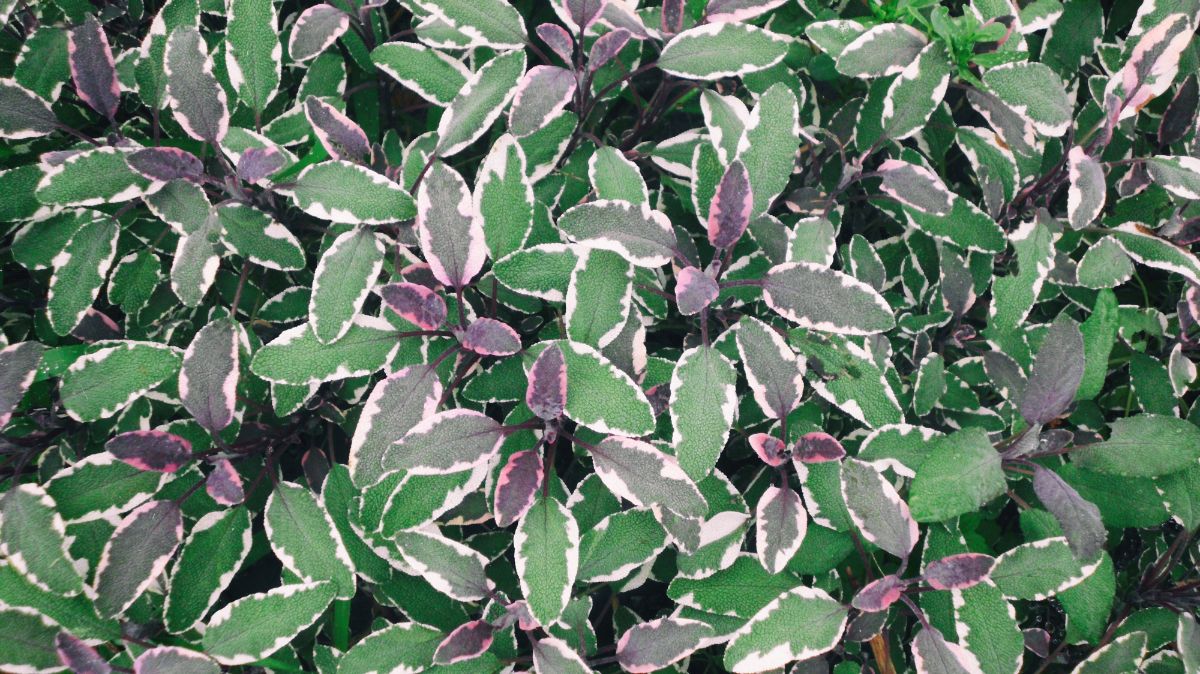
| Plant name: | Tricolor sage |
| Light requirements: | Full sun |
| Water requirements: | Moderate to low |
| Growing zone: | Zones 4 to 11 |
| Special features: | Fragrant; Edible; Attracts pollinators |
Sage is mostly grown as a culinary herb, but it is a lovely plant that has an ornamental appeal as well. While you can opt for common green sage, purple or tricolor sages are particularly alluring and will add something different to your garden as border plants.
Like lavender, sage is edible, and it will emit a fine fragrance when the leaves are crushed underfoot or brushed against during garden walks. Additionally, sage flowers are irresistible to bees!
8. Cinquefoil (Potentilla spp.)
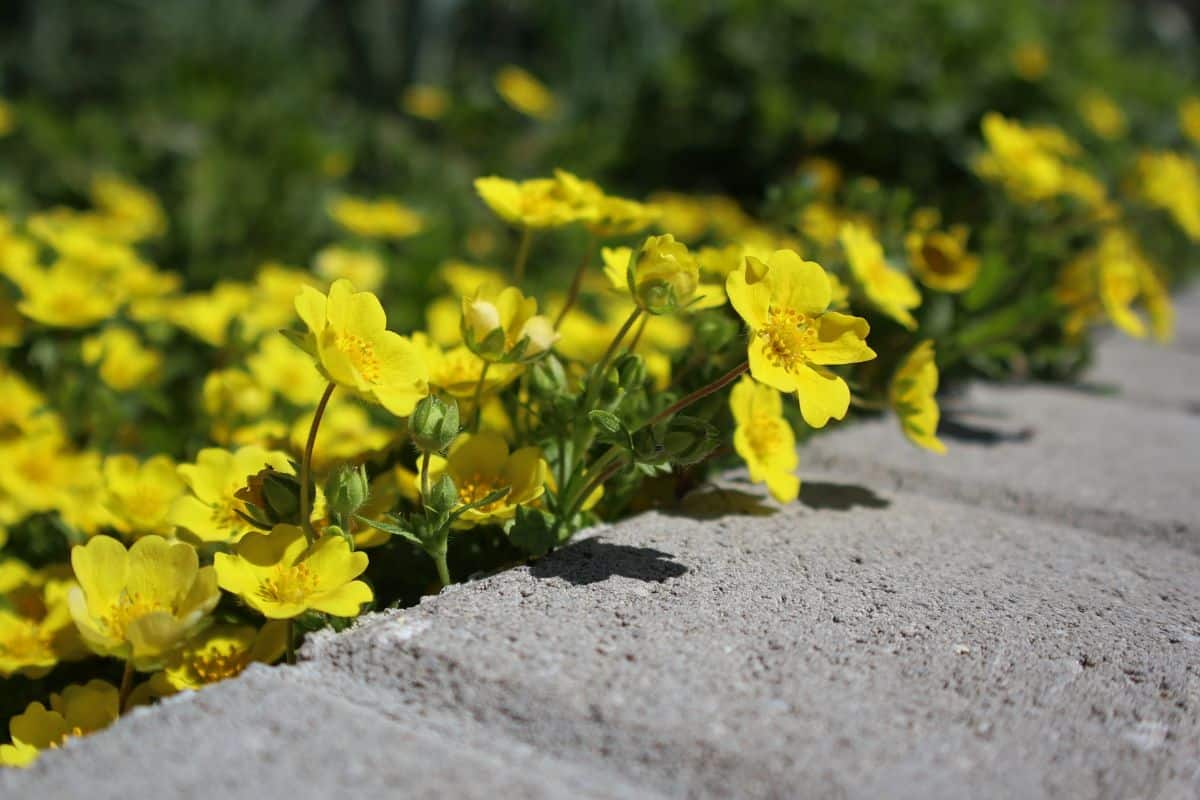
| Plant name: | Cinquefoil |
| Light requirements: | Full sun to part shade |
| Water requirements: | Moderate |
| Growing zone: | Zones 3 to 7 |
| Special features: | Attracts pollinators; Summer flowers |
Cinquefoil is a cheery-looking plant that’s famous for its golden yellow flowers and palmate leaves that are often divided into 5 distinct leaflets. There are a number of different cinquefoils to choose from, including mounding and creeping varieties. Some types can grow quite vigorously and may become weedy, but the mounding varieties are generally easier to maintain, and they can pack a punch in garden beds.
Cinquefoil plants are native to North America, and many varieties are pollinated by bees, butterflies, and other beneficial insects. These plants are sometimes referred to as “five fingers” or “five finger grass,” and they have been used in folk remedies for generations.
9. Sedum (Sedum spp.)
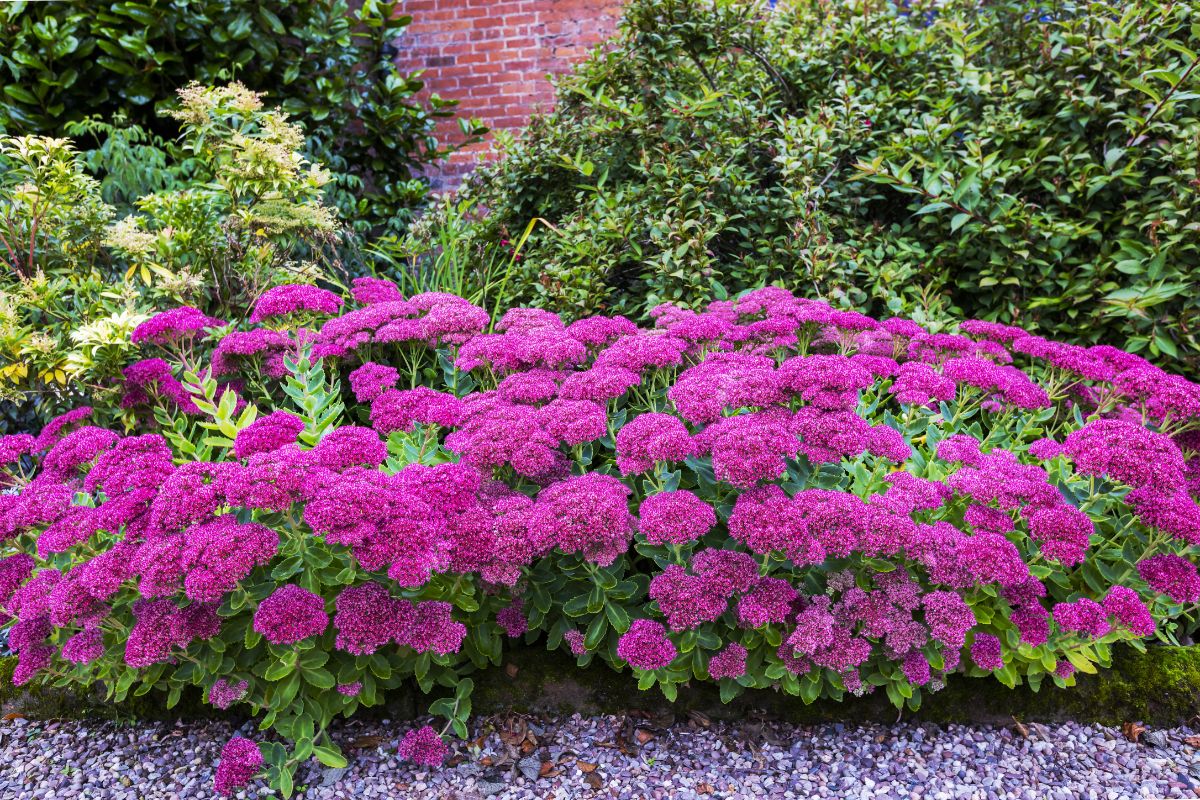
| Plant name: | Sedum |
| Light requirements: | Full sun |
| Water requirements: | Low |
| Growing zone: | Zones 3 to 11 |
| Special features: | Cold hardy; Drought tolerant; Autumn flowers |
Dry gardens can be difficult to grow plants in, especially if you don’t have a water source nearby. But sedums are very drought-tolerant plants that can thrive in areas with minimal water. And, since they come in many different sizes and colors, you can always find sedum that will coordinate with your garden design.
Some sedums grow to about 3’ tall, but you can also locate low-growing sedums that make excellent groundcovers and border plants for garden walkways. These plants bloom later in the season than many other plants, giving you something to look forward to in the autumn garden!
10. Creeping thyme (Thymus serpyllum)
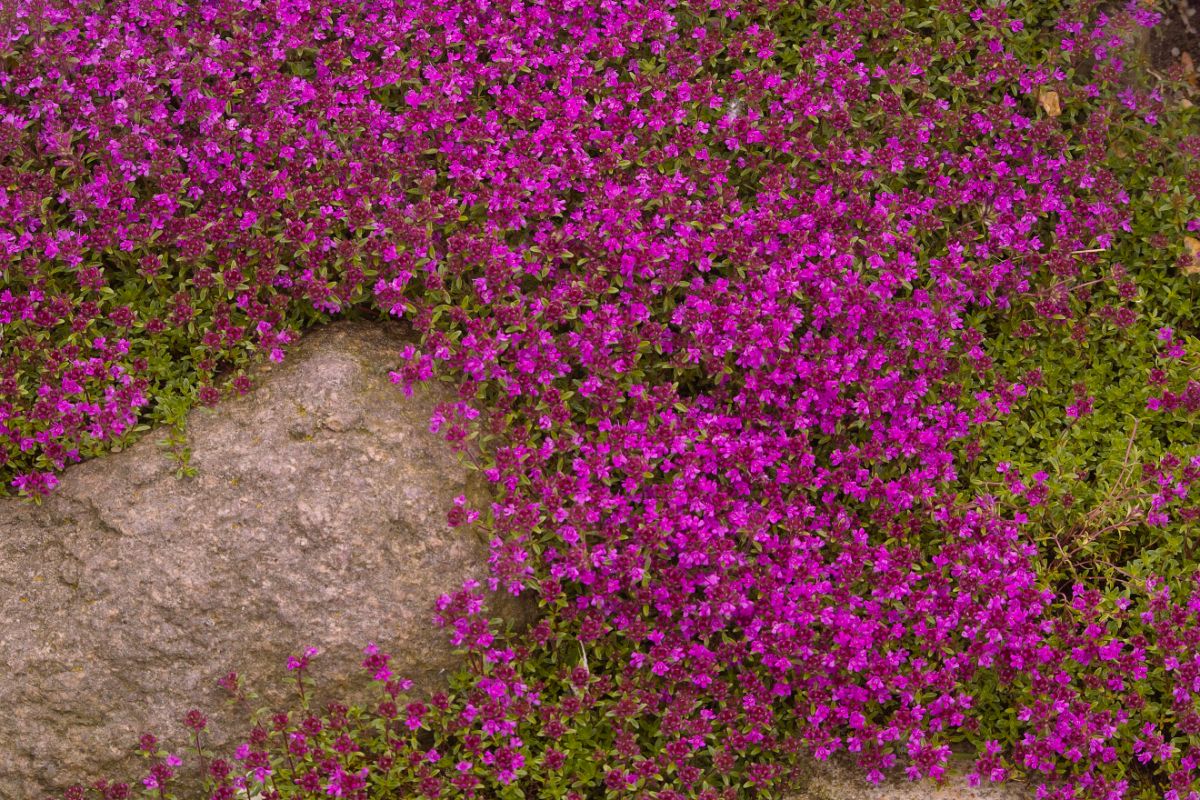
| Plant name: | Creeping thyme |
| Light requirements: | Full sun to part shade |
| Water requirements: | Low |
| Growing zone: | Zones 4 to 9 |
| Special features: | Fragrant; Tolerates light foot traffic |
Like sage, thyme is usually grown as a culinary herb, but it is showy enough to be used as an ornamental as well. Thyme plants can have either green or variegated leaves, and they will also add color to your garden when they flower darling, pinkish-purple flowers from spring to summer.
While you can grow an assortment of thyme species as border plants, creeping thyme is a particularly good option because it grows so low to the ground. As it matures, this spreading plant can be used to fill in spaces in garden paths, and it can even trail over low walls and rock borders.
11. Boxwood (Buxus sempervirens)
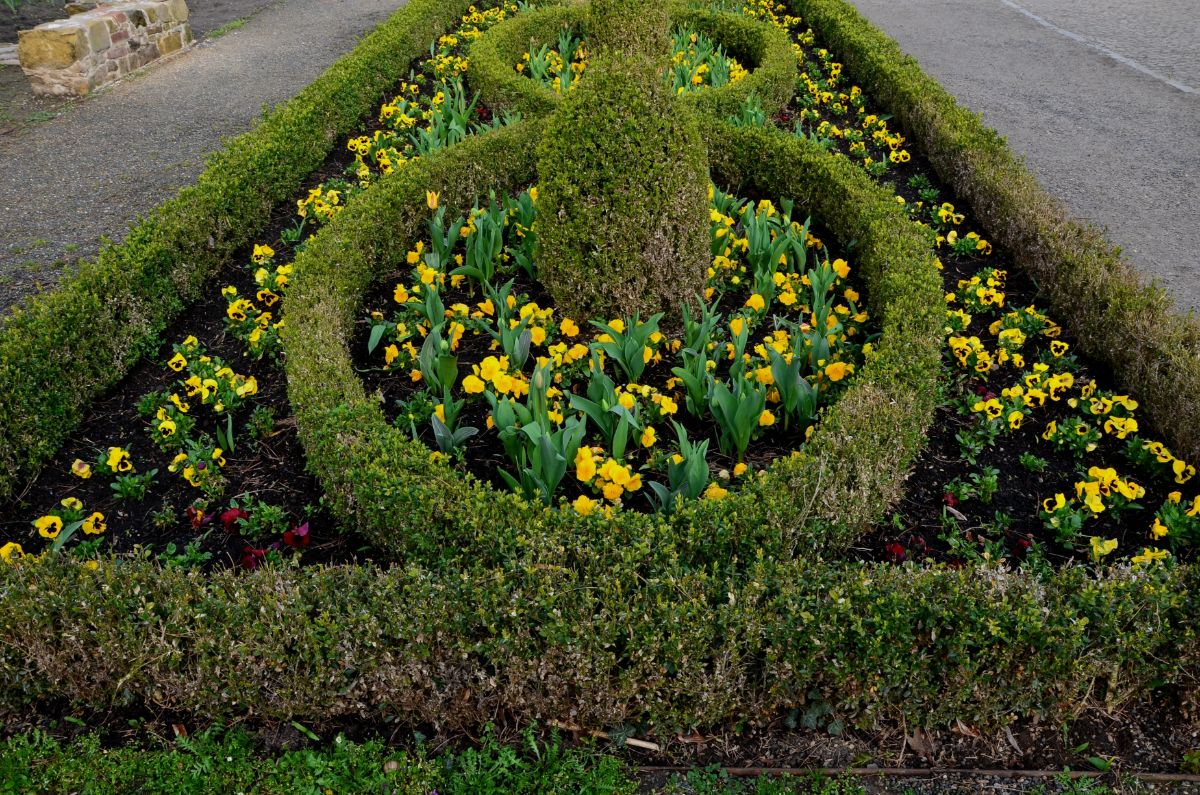
| Plant name: | Boxwood |
| Light requirements: | Full sun to part shade |
| Water requirements: | Moderate to low |
| Growing zone: | Zones 5 to 9 |
| Special features: | Fast growing; Evergreen; Great for formal gardens |
When it comes to formal gardens, boxwood plants are a classic choice, and they can be trimmed into tidy borders and hedges too. Boxwood shrubs keep their glossy, green leaves all winter long, providing color and interest to winter gardens. Plus, they grow quickly and can readily fill in empty spaces in your landscape.
Standard boxwood plants can grow up to 20’ tall, but you can also find dwarf varieties that stay much smaller and rarely grow over 1 to 2’ in height. Try out boxwood in knot gardens, traditional English garden designs, or use them in contemporary landscape settings. It’s up to you!
12. Dwarf fountain grass (Pennisetum alopecuroides)

| Plant name: | Dwarf fountain grass |
| Light requirements: | Full sun |
| Water requirements: | Moderate to low |
| Growing zone: | Zones 4 to 11 |
| Special features: | Attracts birds; Drought tolerant |
Ornamental grasses of all sorts are often grown along garden borders, but dwarf fountain grass is a particularly popular option. This grass type forms neat clumps as it grows, and its slender leaves will catch the breeze beautifully, adding movement and structure to garden designs. These plants also produce pale pink seed ends towards the end of summer, which will add even more interest and help feed wild birds too.
When mature, dwarf fountain grass grows to about 24” tall, and it makes a fine complement for flowering plants, such as lady’s mantle and cinquefoil. Just make sure you locate your plants in full sun!
13. Sweet alyssum (Lobularia maritima)
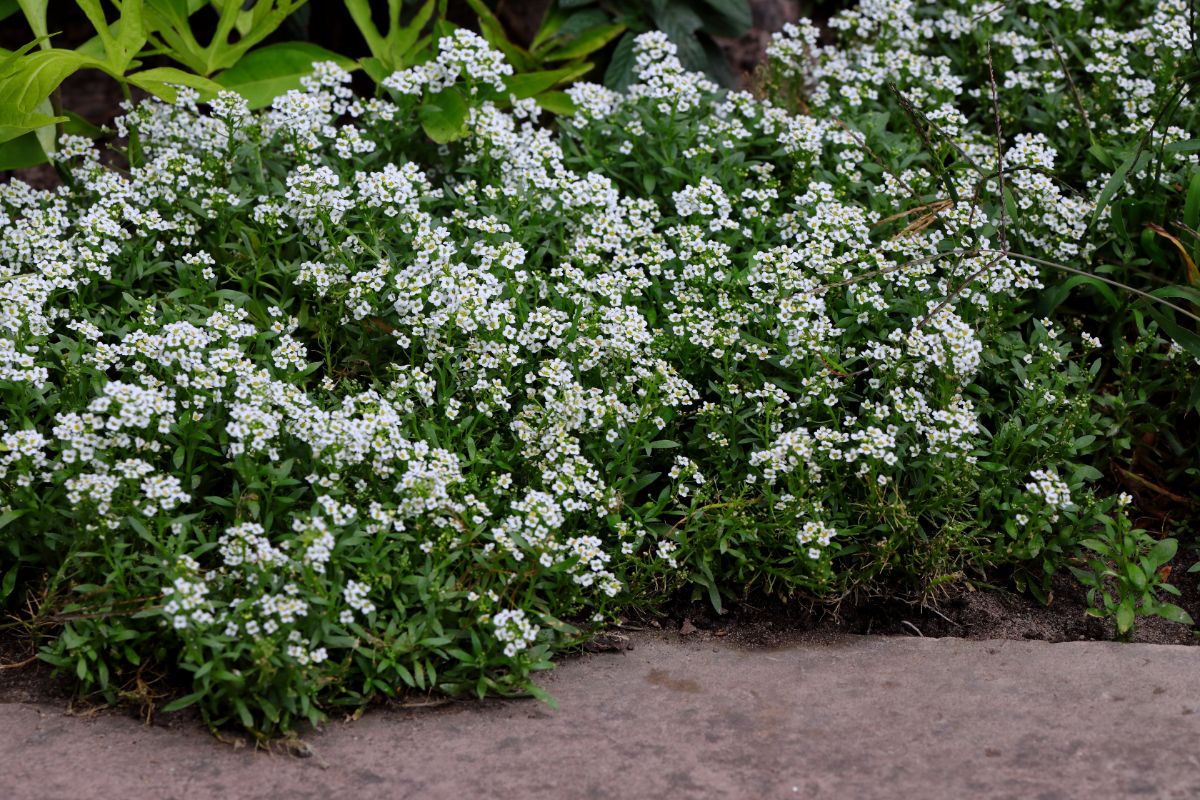
| Plant name: | Sweet alyssum |
| Light requirements: | Full sun to part shade |
| Water requirements: | Moderate |
| Growing zone: | Zones 9 to 11, grown as an annual in colder climates |
| Special features: | Fragrant; Attracts pollinators; Good for natural pest control |
Sweet alyssum is a low-growing, creeping plant that is often grown in containers. But its small size lends itself well to garden beds too, where it makes an exceptional groundcover or border plant.
Sweet alyssum can bloom petite, purple, or white flowers from spring through fall, although blooms may be diminished during the heat of summer. When in flower, sweet alyssum emits a sweet, honey-like fragrance that attracts beneficial insects to your garden. In addition to being a lovely ornamental, sweet alyssum is often grown as a companion plant in vegetable gardens to control pests and insects naturally.
14. Lady’s mantle (Alchemilla mollis)
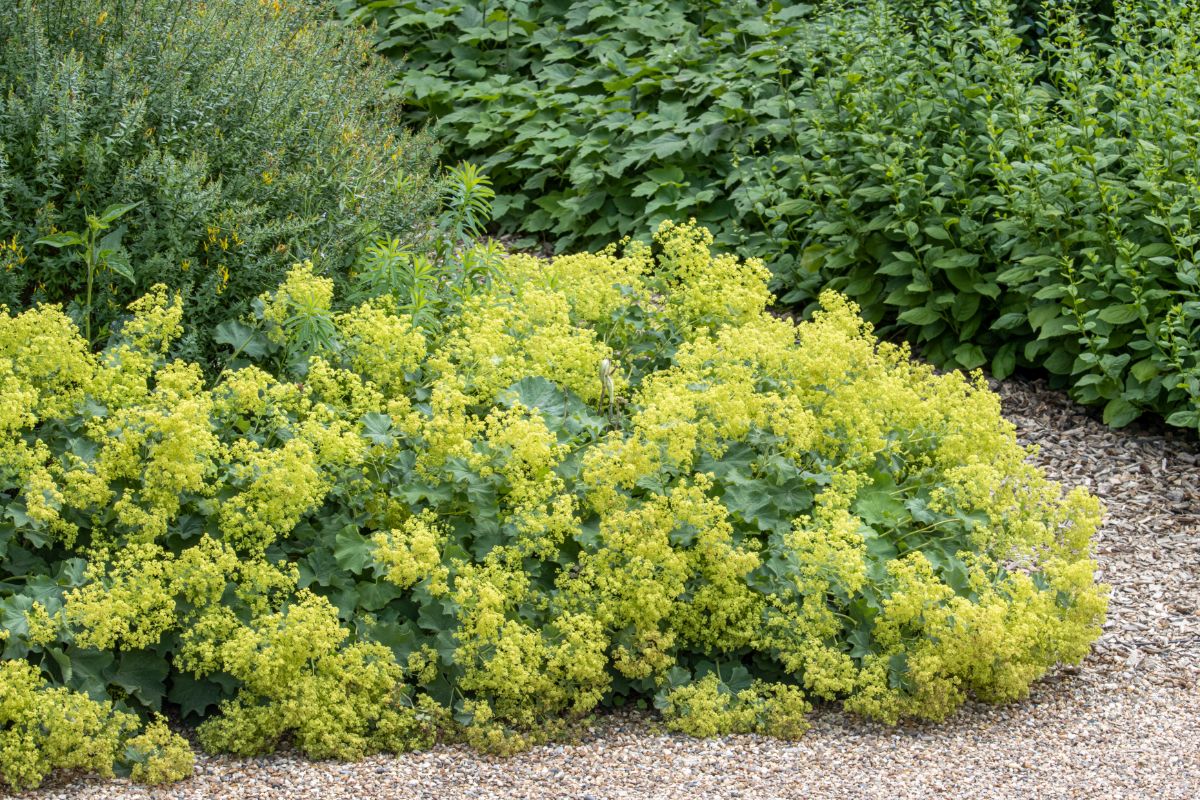
| Plant name: | Lady’s mantle |
| Light requirements: | Full sun to shade |
| Water requirements: | Moderate to low |
| Growing zone: | Zones 3 to 8 |
| Special features: | Attracts pollinators; Perfect for cottage gardens; Shade tolerant |
Lady’s mantle is a stately plant that is often grown in pollinator gardens, but it makes a fetching border plant in cottage gardens and other landscape designs too. When mature, the lady’s mantle grows to about 24” tall, and it is mostly known for its distinct, fan-shaped leaves that sparkle in the morning with dew drops. These plants will also attract pollinators when they bloom pretty, yellow flowers from late spring to early summer.
Thanks to their low growth habit, lady’s mantle pairs well with an assortment of classic cottage garden flowers, including coneflowers, catmint, and phlox. However, if you live in a very hot climate, you may want to grow a lady’s mantle in a section of your yard that receives partial shade to ward against sun scorch.
15. Irish moss (Sagina subulata)
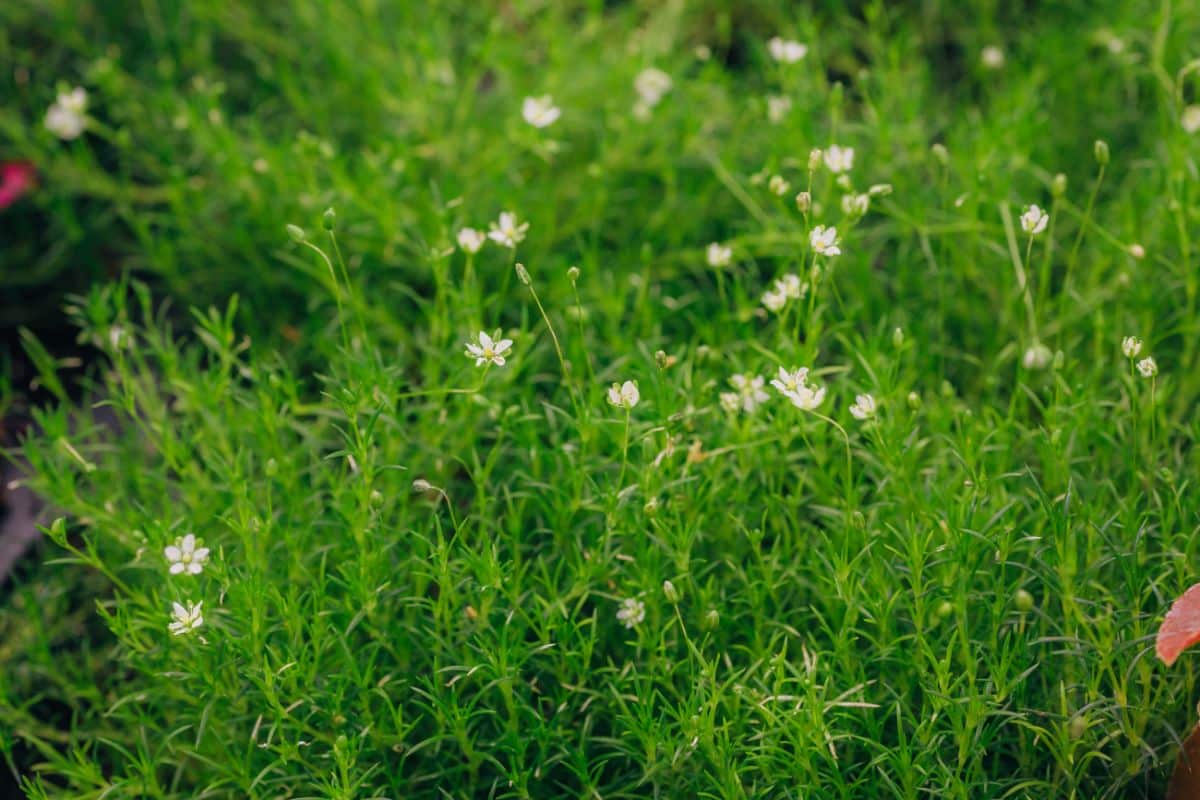
| Plant name: | Irish moss |
| Light requirements: | Full sun to part shade |
| Water requirements: | High |
| Growing zone: | Zones 4 to 8 |
| Special features: | Tolerates light foot traffic |
Irish moss may look delicate, but it can make a big impact in gardens, especially if you plant a lot of it. Irish moss only grows to about 2” tall, but each plant can spread over 10” wide, and the dainty leaves look appealing when they trail over low walls and rock borders. Irish moss is also often planted in walkways as it can handle some foot traffic.
With rich, green, feathery leaves, Irish moss will draw the eye all season long, but it looks even more magical when it flowers dainty, white blooms in spring and summer. While Irish moss can be grown in a variety of landscapes, it is a must-have plant in fairy gardens!
16. Astilbe (Astilbe spp.)
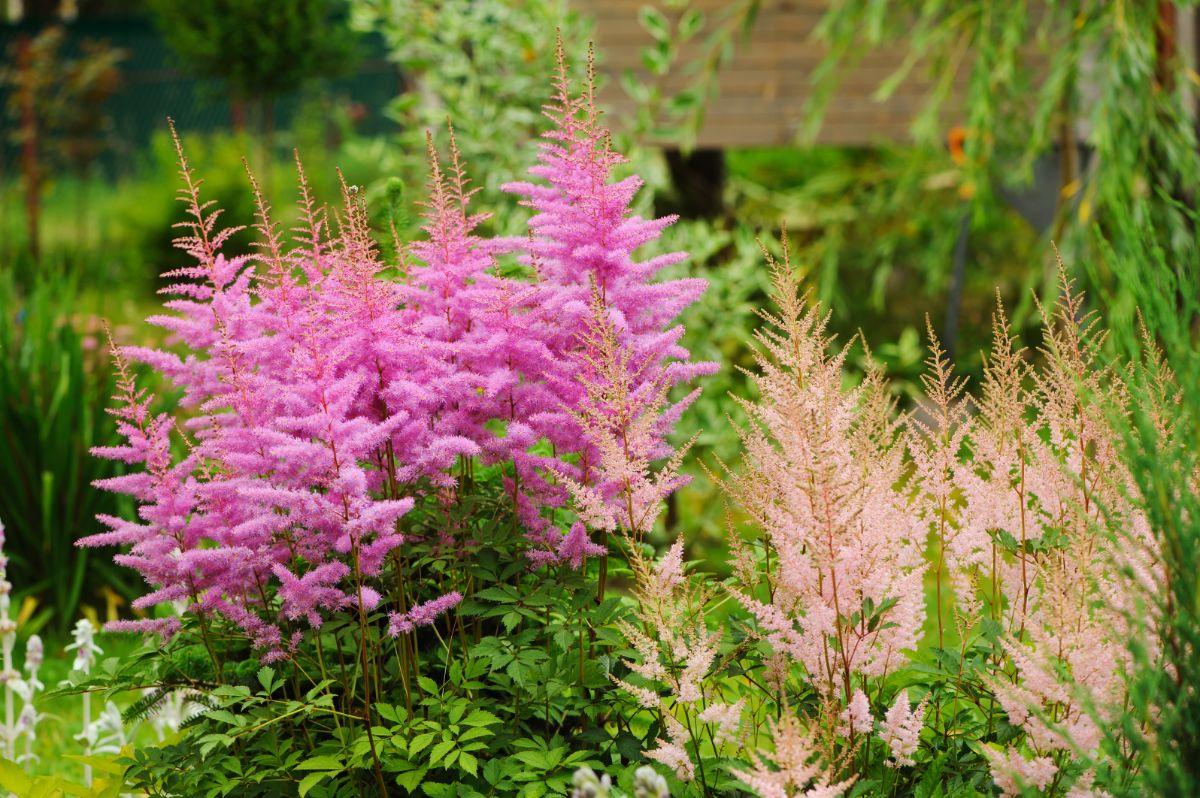
| Plant name: | Astilbe |
| Light requirements: | Full sun to part shade |
| Water requirements: | Moderate |
| Growing zone: | Zones 3 to 8 |
| Special features: | Cold tolerant; Divides easily |
Astilbe is a rugged plant that can adapt to most gardens, and it doesn’t need to be pampered like some other ornamentals. If you’re looking for a no-nonsense plant that can handle full sun to part shade and slightly acidic soil, astilbe may be just the plant you need.
While astilbe can be used to fill in garden beds and soften borders with its textured leaves, these plants are mostly known for their tall and colorful flowers. Astilbe blooms come in various shades of pink, white, purple, and red, and they flower from May to August. Like daylilies, astilbe also grows rapidly, and it can be easily divided, providing you with lots of new plants to grow throughout your garden.
17. Catmint (Nepeta racemosa)

| Plant name: | Catmint |
| Light requirements: | Full sun to part shade |
| Water requirements: | Moderate |
| Growing zone: | Zones 3 to 8 |
| Special features: | Fragrant; Cold hardy; Deer resistant |
Catmint is another captivating edging plant that can be used to soften borders and add extra color to your planting arrangements. Catmint plants have a soft and airy quality to them, with pale purple flowers that pair exceptionally well with purple, yellow, and blue blooms. These plants are also classics in cottage garden landscapes, and they’re often grown with lady’s mantle, phlox, and other hardy ornamentals.
Like many other plants in the mint family, catmint can spread, but it isn’t quite as aggressive as some other mint species. This plant is also fragrant, and it is known to repel deer. So, if you’re gardening in an area where deer are abundant, you may want to grow catmint as a practical border plant to safeguard your other flowers.
18. Mophead hydrangea (Hydrangea macrophylla)
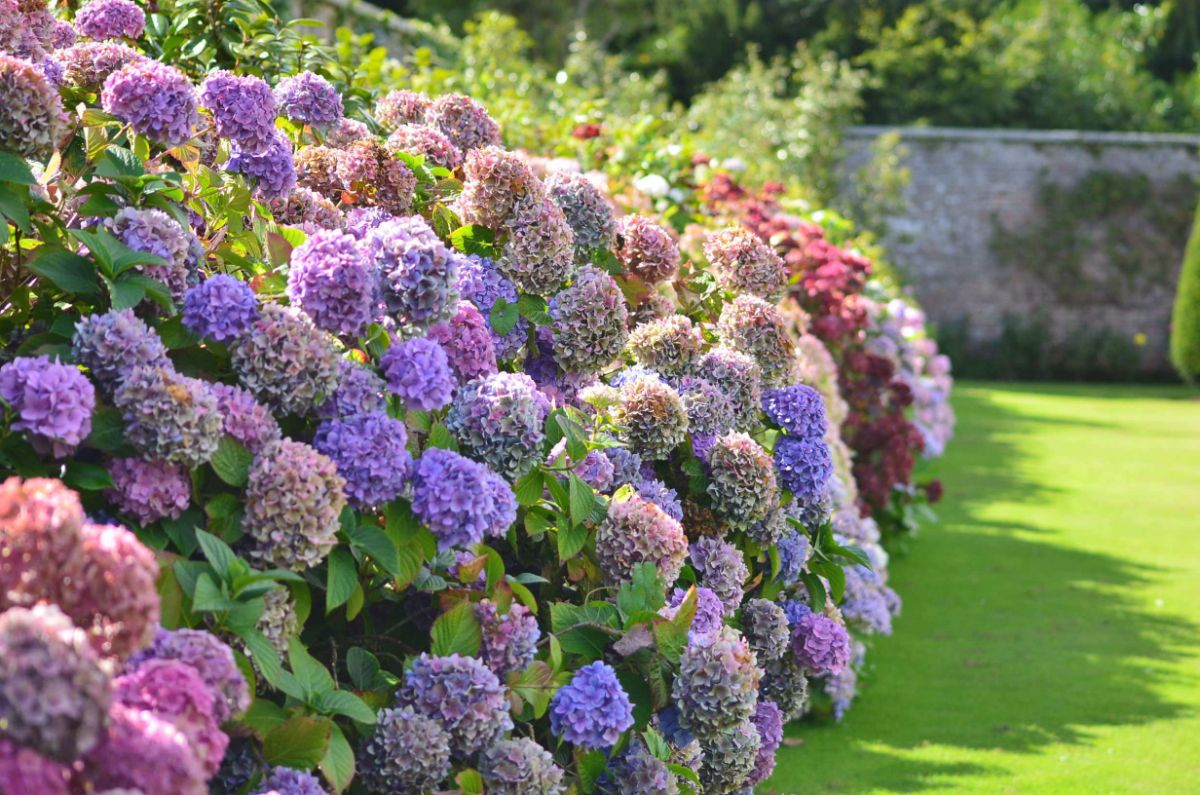
| Plant name: | Mophead hydrangea |
| Light requirements: | Full sun to part shade |
| Water requirements: | Moderate |
| Growing zone: | Zones 5 to 9 |
| Special features: | Large flower heads; Great for dried arrangements; Salt tolerant |
Mophead hydrangeas are taller plants and usually grow to about 3 to 6’ in height, but if you’re constructing a low-maintenance garden or you want a larger border plant, mophead hydrangeas are hard to beat. Unlike some other hydrangea varieties, mophead hydrangeas have large, colorful flower heads that can change in hue based on the soil’s pH. These plants are also quite salt tolerant, which is why they are often grown in coastal gardens.
While hydrangeas thrive in full sun, they may grow even better in an area with partial afternoon shade if you live in a very hot climate. Hydrangea flowers also dry incredibly well, so if you love crafting, these border plants can give you fresh ingredients to work with!
19. Moss phlox (Phlox subulata)
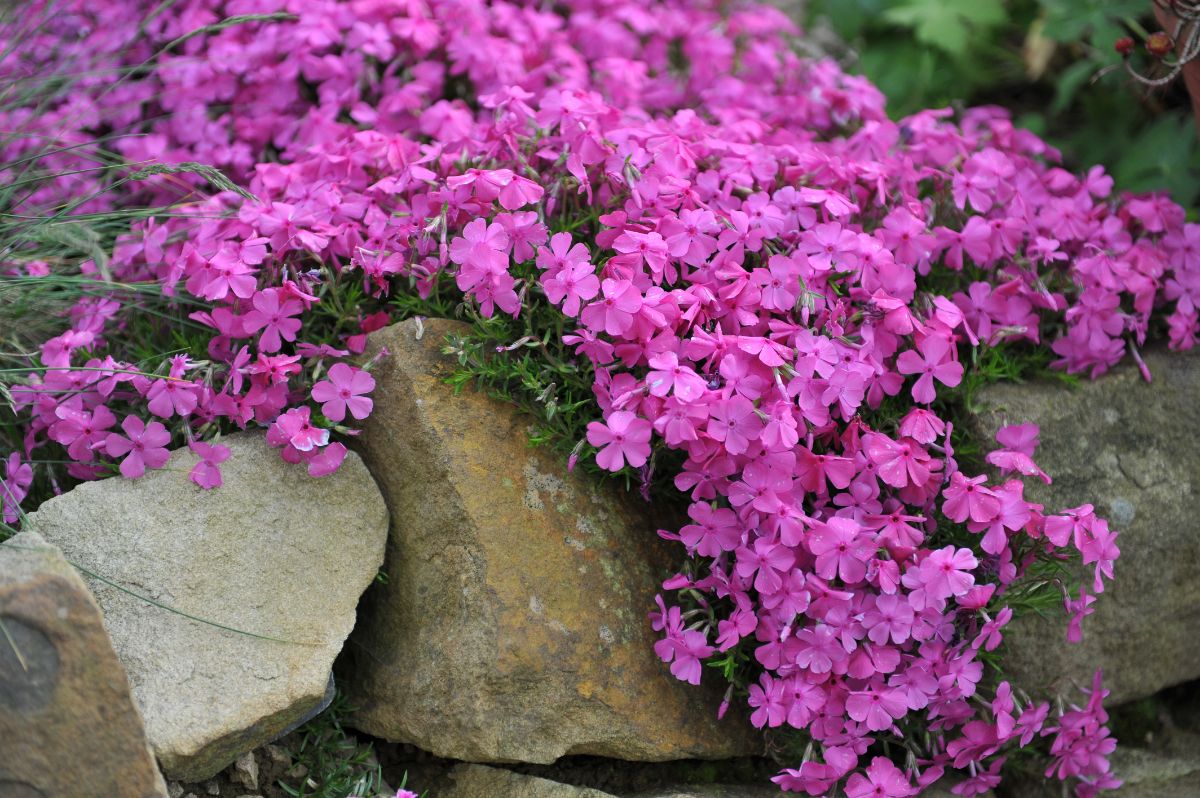
| Plant name: | Moss phlox |
| Light requirements: | Full sun to part shade |
| Water requirements: | Moderate |
| Growing zone: | Zones 5 to 9 |
| Special features: | Spring flowers; Perfect for cottage gardens |
Also known as creeping phlox, moss phlox is a common sight in spring gardens, where it can form large mats of colorful flowers. Phlox blooms range in color from white to pink, and they are some of the first flowers to bloom in spring, providing an important food source for pollinators.
Moss phlox only grows to about 6” tall, making it a perfect height for the front of garden beds and for planting along walkway borders. If you love the look of cottage gardens, moss phlox is a top plant to grow. Plus, its hardy nature means it will come back year after year with minimal effort.
20. Azaleas (Rhododendron spp.)
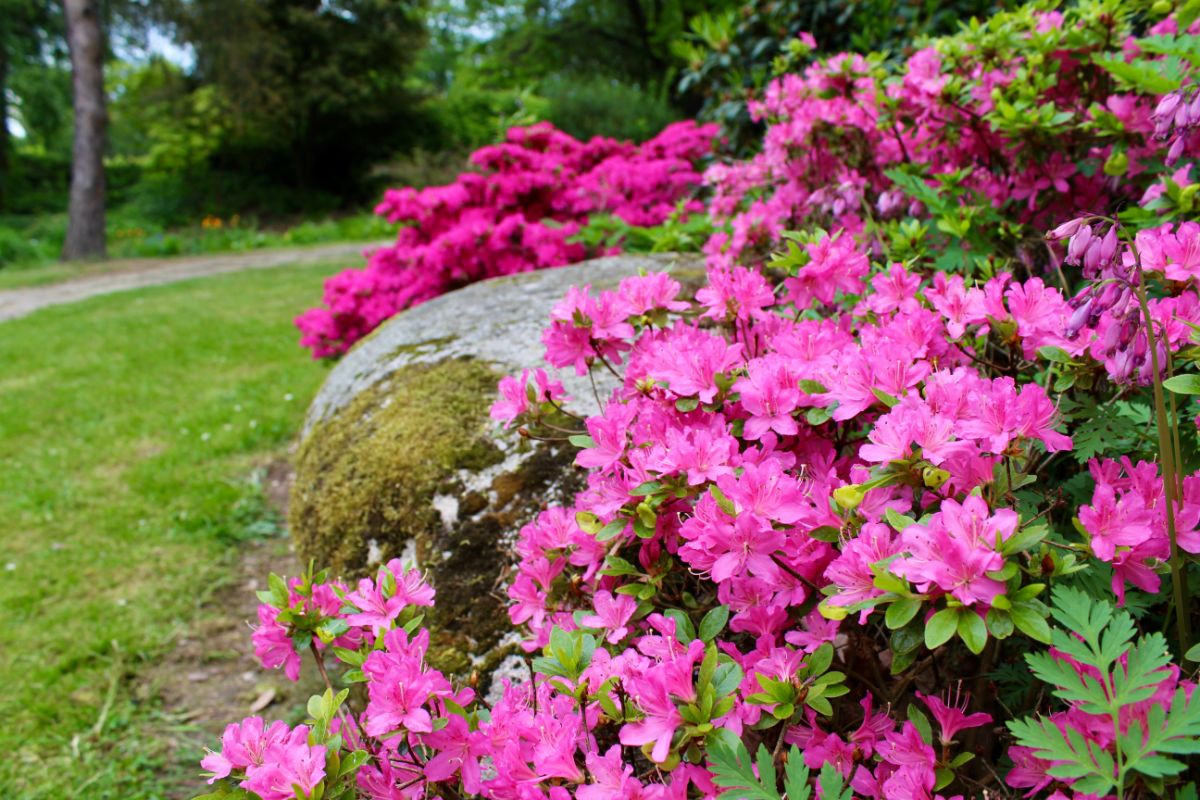
| Plant name: | Azaleas |
| Light requirements: | Full sun to part shade |
| Water requirements: | Moderate |
| Growing zone: | Zones 4 to 9, depending on variety |
| Special features: | Showy flowers; Evergreen foliage |
Azaleas are staple plants in southern gardens, and they are only partially cold-hardy. But if you live in a warmer climate, azaleas are a common border plant to grow, particularly because they produce such a sensational springtime show when they flower! There are also several more cold-hardy varieties, so if you live in a climate colder than zone 6 and you want azaleas in your borders, shop for more cold-hardy varieties. These plants are also evergreen, which means you can enjoy their rich green leaves all year round.
Most azaleas bloom in spring, but you can find reblooming azalea varieties that flower throughout summer and fall. Azaleas’ trumpet-shaped flowers are highly attractive to hummingbirds, and they come in lots of colors, including salmon, purple and red. While some azaleas grow over 20’ tall, dwarf azalea varieties stay between 2 ½ to 3’ in height and are ideal for border plantings and container gardens too.
Summary
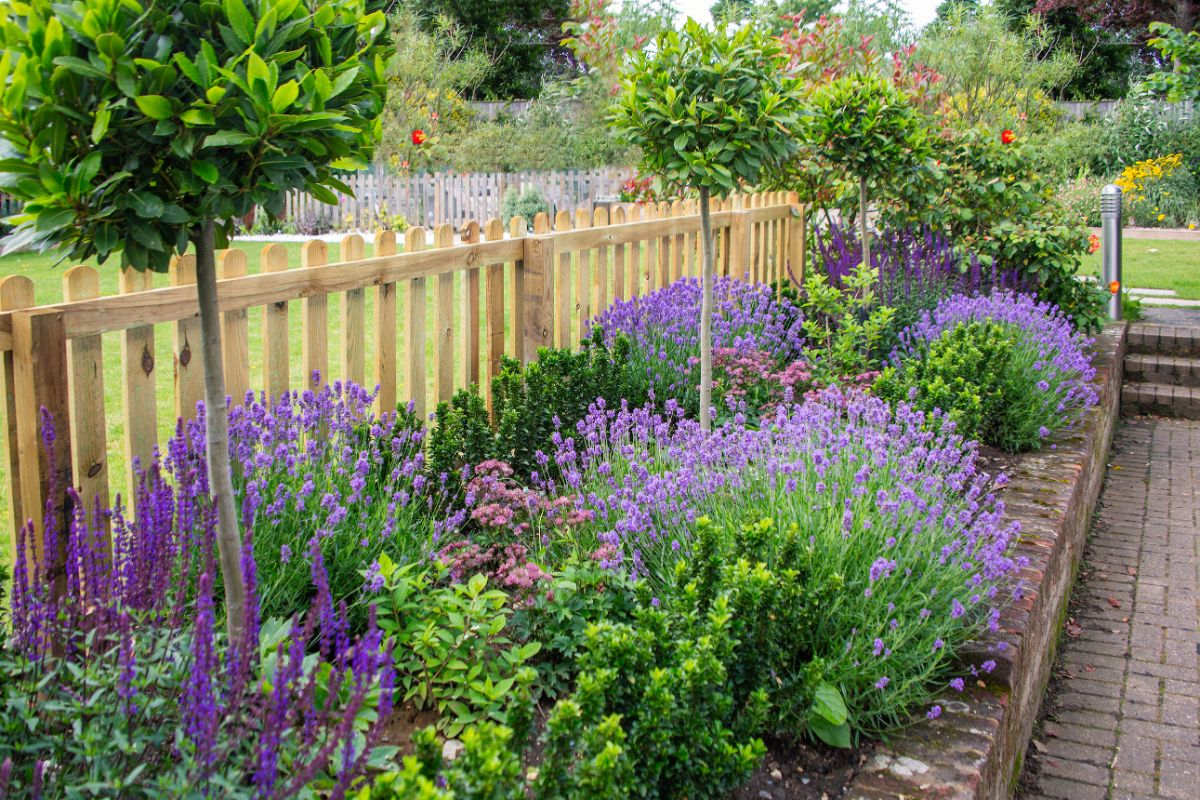
From low-growing creeping thyme to tall, mophead hydrangeas, border plants come in all shapes, sizes, and colors. But one thing all border plants have in common is that they will bring extra interest to your garden and make your landscape design look more finished and cohesive.
Hardy border plants can grow in a wide range of climates and growing conditions, and some tough species can even handle foot traffic, making them appropriate for garden walkways and hellstrip garden spaces. No matter what border plants you choose to grow, adding easy care edging plants is one simple way to bring your landscape together and create a more complex planting arrangement.
In addition to border plants, ornamental beds are often interplanted with foundation plants and other annuals and perennials. If you’re looking for more inspiration for your planting designs, check out our guide on these small shrubs and trees that can serve as foundation plants in many different garden settings. You may also want to explore our list of the best perennials for shady gardens or these tall perennials that will form a perfect complement to low-growing border plants.

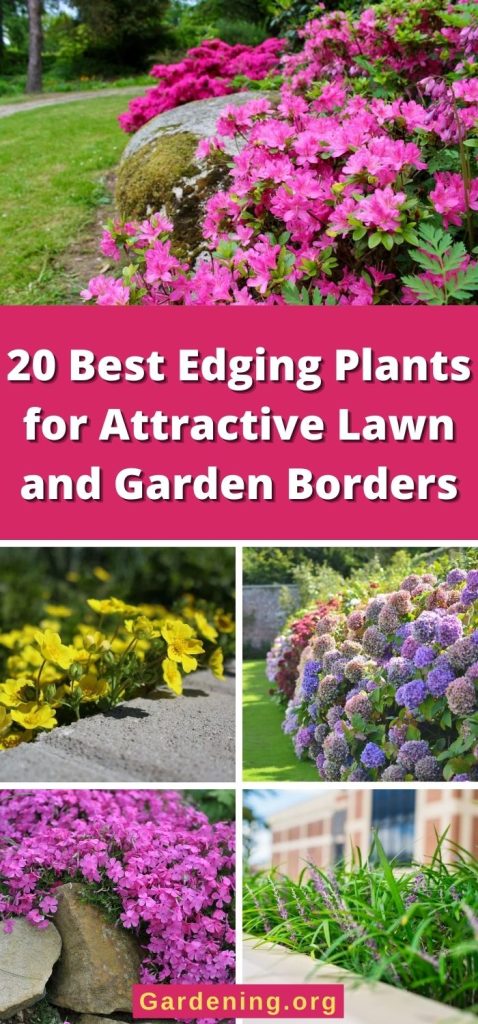
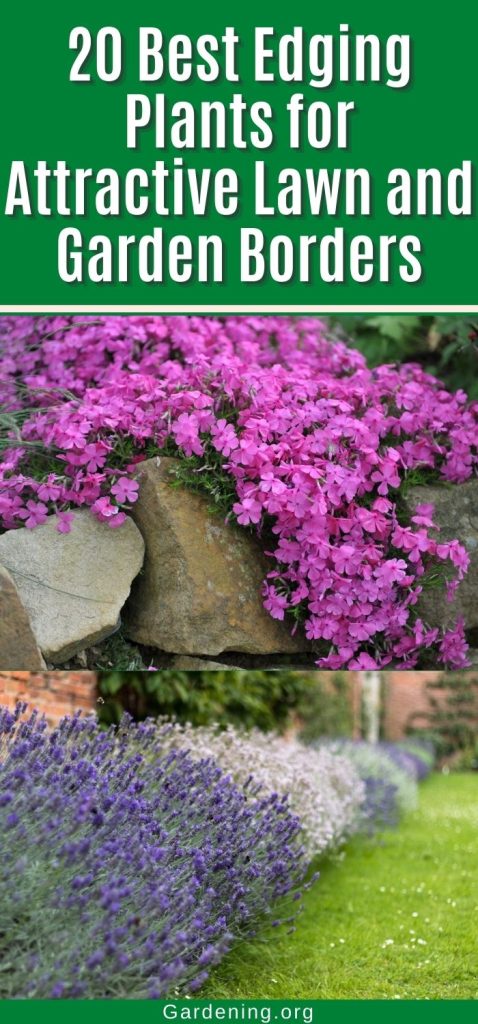
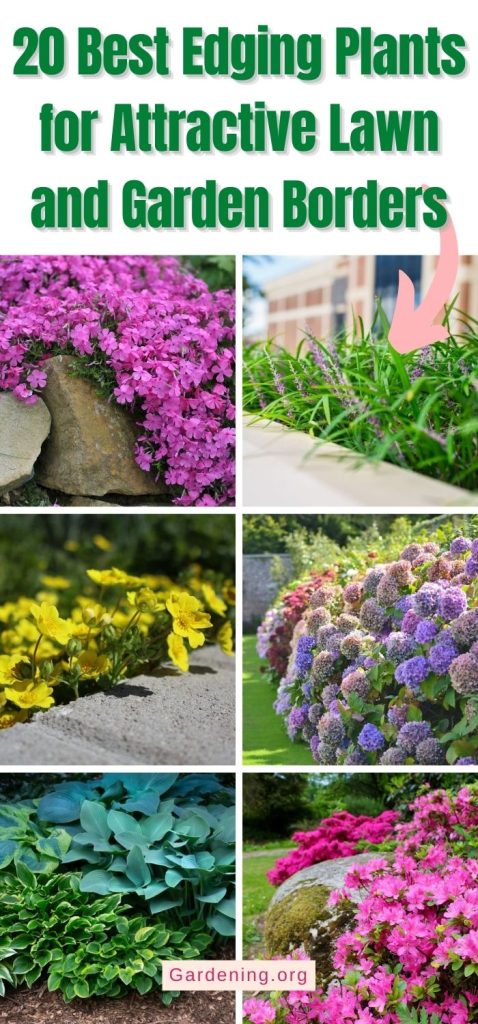
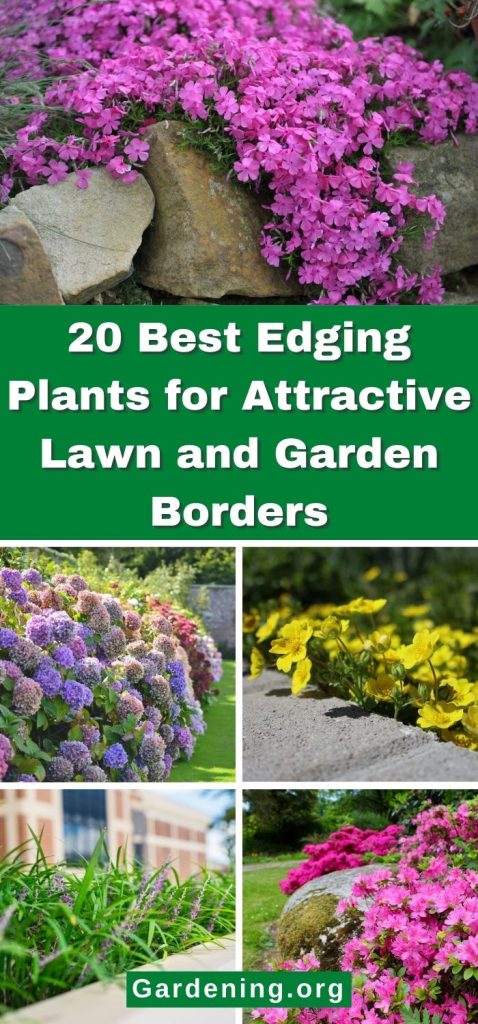




Katrina LWHITE
Are any of these, deer resistant?
Mary Ward
Japanese wisteria and lavender are. Alyssum is.
Katrina LWHITE
Are any of these deer resident?